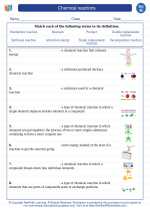Chemical reactions -> chemical equations
What is a Chemical Equation?
A chemical equation is a symbolic representation of a chemical reaction. It shows the reactants (substances that undergo the reaction) on the left side and the products (substances formed as a result of the reaction) on the right side. The equation provides information about the relative quantities of reactants and products involved in the reaction.
Parts of a Chemical Equation
A chemical equation consists of the following parts:
- Reactants: These are the substances that are present at the beginning of the reaction and undergo chemical change.
- Products: These are the substances that are formed as a result of the chemical reaction.
- Chemical Symbols: These symbols represent the elements involved in the reaction, such as H for hydrogen, O for oxygen, and so on.
- Coefficients: These are the numbers written in front of the chemical formulas to balance the equation and indicate the relative quantities of each substance involved.
Balancing Chemical Equations
It is important to balance chemical equations to ensure that the law of conservation of mass is obeyed. This law states that matter cannot be created or destroyed in a chemical reaction, so the total mass of the reactants must be equal to the total mass of the products.
When balancing a chemical equation, coefficients are adjusted in front of the formulas to ensure that the same number of each type of atom is present on both sides of the equation.
Types of Chemical Reactions
Chemical reactions can be classified into different types based on the nature of the reaction. Common types of chemical reactions include:
- Synthesis Reactions: Two or more substances combine to form a single product.
- Decomposition Reactions: A single compound breaks down into two or more simpler substances.
- Single Replacement Reactions: One element replaces another element in a compound.
- Double Replacement Reactions: The cations and anions of two different compounds switch places, forming two new compounds.
- Combustion Reactions: A substance reacts with oxygen, often producing heat and light as well as new compounds.
Stoichiometry and Chemical Equations
Stoichiometry is the study of the quantitative relationships between reactants and products in chemical reactions. It involves using the coefficients in a balanced chemical equation to determine the amounts of reactants needed and products produced in a reaction.
Stoichiometry calculations can involve determining the mass, moles, or volume of substances involved in a reaction, as well as predicting the yields of products based on the amounts of reactants.
Study Guide for Chemical Equations
To understand chemical equations and reactions effectively, it's important to:
- Learn the basic symbols and formulas of common elements and compounds.
- Practice balancing chemical equations by adjusting coefficients.
- Understand the different types of chemical reactions and their characteristics.
- Master stoichiometry calculations to relate the quantities of reactants and products in a chemical reaction.
- Apply the concept of conservation of mass to ensure balanced chemical equations.
By mastering these concepts and skills, you will be well-equipped to understand and analyze various chemical reactions and their mathematical representations through chemical equations.
[Chemical Equations] Related Worksheets and Study Guides:
.◂Science Worksheets and Study Guides Eighth Grade. Chemical reactions
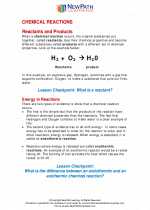
 Activity Lesson
Activity Lesson
 Worksheet/Answer key
Worksheet/Answer key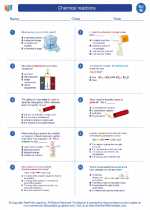
 Worksheet/Answer key
Worksheet/Answer key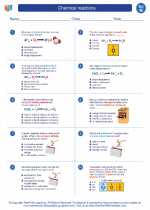
 Worksheet/Answer key
Worksheet/Answer key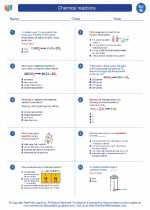
 Worksheet/Answer key
Worksheet/Answer key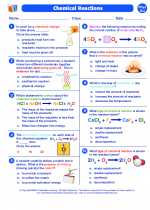
 Vocabulary/Answer key
Vocabulary/Answer key
 Vocabulary/Answer key
Vocabulary/Answer key